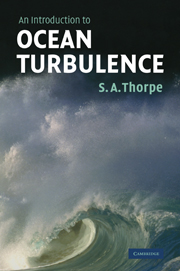Book contents
- Frontmatter
- Contents
- Preface
- Notes on the text
- Acknowledgements
- Abbreviations
- Standard parameters and symbols
- Units and their symbols
- SI prefixes
- Approximate values of commonly used measures
- 1 Turbulence, heat and waves
- 2 Measurement of ocean turbulence
- 3 Turbulence in oceanic boundary layers
- 4 Turbulence in the ocean pycnocline
- 5 Turbulent dispersion
- 6 The energetics of ocean mixing
- References
- Index
- Answers
Answers
Published online by Cambridge University Press: 05 June 2012
- Frontmatter
- Contents
- Preface
- Notes on the text
- Acknowledgements
- Abbreviations
- Standard parameters and symbols
- Units and their symbols
- SI prefixes
- Approximate values of commonly used measures
- 1 Turbulence, heat and waves
- 2 Measurement of ocean turbulence
- 3 Turbulence in oceanic boundary layers
- 4 Turbulence in the ocean pycnocline
- 5 Turbulent dispersion
- 6 The energetics of ocean mixing
- References
- Index
- Answers
Summary
These are possible answers to the problems set at the end of each chapter in An Introduction to Ocean Turbulence. Alternative or simpler answers may be possible in some cases. Please advise the author if any errors are found.
Chapter 1
P1.1. Integrating over the area of the tube, the net flow is ∫0au ⋅ 2π r. dr = 4π U ∫ (r − r3/a2)dr = 4π U[r2/2 − r4/(4a2)]0a=π Ua2. By definition, this must be equal to the mean flow times the cross-sectional area, π a2, so U is equal to the mean flow. By conservation of the volume flux, the mean flow downstream of the transition from laminar to turbulent flow must also be equal to U.
The flux of kinetic energy upstream of the transition from laminar to turbulent flow is u(ρ u2/2) integrated over the cross-section of the tube, i.e., ∫0a (ρ u3/2)⋅ 2π r dr = 8π ρ U3∫0ar(1 − r2/a2)3 dr = − π ρ U3a2[(1 − r2/a2)4]0a = π ρ U3a2.
In the same way, the flux of the kinetic energy of the mean flow is (ρ U3/2)π a2 within the turbulent flow downstream of the transition, so the reduction in the flux is the difference between the flux upstream of the transition and that downstream, or (ρ U3/2) π a2. This represents a flux of kinetic energy to the turbulent motion, ignoring any work done by pressure forces.
- Type
- Chapter
- Information
- An Introduction to Ocean Turbulence , pp. 241 - 267Publisher: Cambridge University PressPrint publication year: 2007



